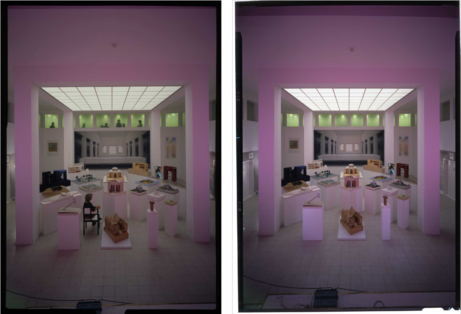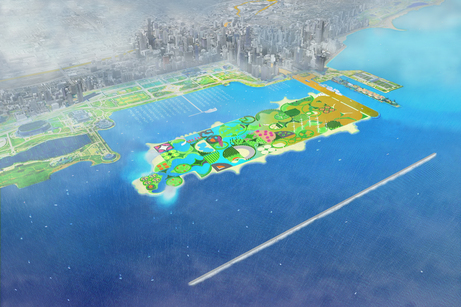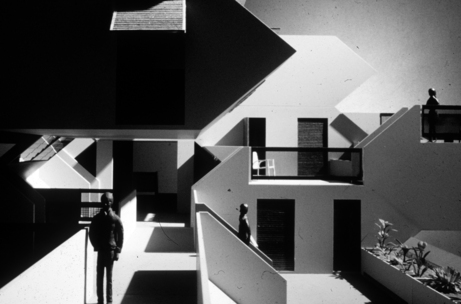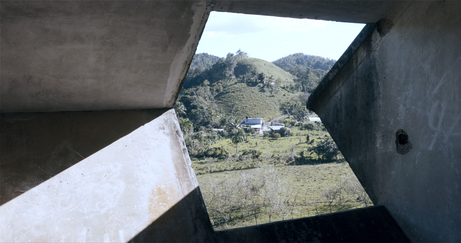Madlener House
4 West Burton Place
Chicago, Illinois 60610
Telephone: 312.787.4071
info@grahamfoundation.org

Atelier Markgraph, photograph for cover of Nouveau Plaisirs d’architectures catalog (1984)
Oliver Elser, historian and curator, will present his lecture Models of Postmodernism–Postmodernisms Models. Elser will examine the founding of the Deutsches Architekturmuseum in Frankfurt in 1984. His lecture focuses on German architectural collector and founder Heinrich Klotz, and architect Oswald Mathias Ungers and their collaboration to produce a model museum in a historic villa.
Oliver Elser is a curator at the Deutsches Architekturmuseum (DAM) in Frankfurt, Germany. His practice includes criticism, teaching, and archival based exhibition making. After studying architecture at the Technical University of Berlin, Elser worked in Vienna as an architecture critic and journalist, publishing often in Der Standard, Architectural Digest, and profil. He has taught scenography at the University of Applied Sciences in Mainz and has shown work at the 2013 Venice Biennale in the exhibition Il Palazzo Enciclopedico. Exhibitions that he has curated include: The Architecture Model: Tools, Fetish, Small Utopia, DAM (2012); The 387 Houses of Peter Fritz, Venice Art Biennale (2013); Mission: Postmodern. Heinrich Klotz and the Wunderkammer, DAM (2014); Making Heimat. Germany, Arrival Country, German Pavilion at the Venice Architecture Biennale (2016); and SOS BRUTALISM – Save the Concrete Monsters!, DAM (2017).
This program is presented in partnership with the 2017 Chicago Architecture Biennial.

Chicago Architecture Biennial Rooms for Books
Chicago Cultural Center
77 E Randolph Street, Chicago, IL 60601
Join us for a day-long series of programs presented by the Graham Foundation Bookshop and the Chicago Art Book Fair in the Rooms for Books at the Chicago Architecture Biennial. Throughout the afternoon, three exhibitors in the Book Fair will share current work and reflect on the conceptual process and physical project of making and designing books.
PROGRAM OF EVENTS
Bricks from the Kiln #3 Listening Preview
12:30 p.m.
Andrew Lister and Matthew Stuart give a multimedia preview of the third issue of Bricks from the Kiln with a four-part audio installation in each of the Rooms for Books quadrants.
The Managerial Arts of Books and Prosthetics with Soberscove Press
3:30 p.m.
On the occasion of Soberscove Press’ release of its new title, The Hysterical Material, designer David Khan-Giordano and editor Geof Oppenheimer discuss their approach to the art of catalog production with publisher Julia Klein.
The London Centre for Book Arts Show-and-Tell
5:00 p.m.
Ira Yonemura and Simon Goode describe the work of the London Centre for Book Arts and situate their practice within contemporary publishing in the UK.
PARTICIPANTS
Bricks from the Kiln, edited and designed by Andrew Lister and Matthew Stuart between Chicago and London, borrows its title from the glossary notes of Ret Marut's Der Ziegelbrenner, which was the 'size, shape and colour of a brick,' and ran for 13 issues between 1917 and 1921. Each issue of Bricks from the Kiln is ‘tentative, incomplete and inconsistent’ and ‘in flux and liable to crack.’
Soberscove Press seeks to make available art-related materials that fill a gap in the literature or are difficult to access (e.g. out-of-print, not in translation, previously unpublished, or limited in circulation). Their books tend to explore modes and functions of documentation and connect historical themes and issues to the present.
David Khan-Giordano lives and works in Chicago.
Geof Oppenheimer is an Associate Professor of Practice in the Arts at the University of Chicago. His practice takes up questions of civic value, the ways in which political and social structures are encoded in images and objects and how meaning is formed in the modern world.
The London Centre for Book Arts (LCBA) is an artist-run, open-access studio providing education programmes for the community and access to resources for artists, designers and makers.
PARTNERS
The Chicago Art Book Fair is dedicated to showcasing emerging directions and diverse legacies within small press arts publishing. The fair features an international group of over 100 arts publishers, small presses, book artists, comics artists, zinemakers and printmakers. The fair takes place from November 16–19 in the Chicago Athletic Association, and will also feature satellite programming and after parties. CABF is free and open to the public.
Rooms for Books is an installation conceived by MG&Co. for the 2017 Chicago Architecture Biennial. It transforms the traditional bookshop into a platform for reflection and for the presentation, documentation, production, and dissemination of the architecture book.

Filter Island, positioned between the Chicago River and Lake Michigan, Chicago
UrbanLab will present their new Graham funded book, Bowling: Water, Architecture, Urbanism, which investigates the symbiotic relationships between architectures of quality and infrastructures of quantity in Chicago, New York, and the Sun Belt. The book is a conjecture of what a comprehensible city could be to combat (real and predicted) natural crises—through design-based analysis and experimentation.
UrbanLab is an architecture and urban design office cofounded by Sarah Dunn and Martin Felsen. The practice blends design and research to produce uniquely progressive, site-specific projects, resulting in a new aesthetic for environmentally resilient architecture, landscapes, and public space. The office’s realized projects range in scale from small houses to urban districts.
Sarah Dunn received her BA from Columbia College and her MArch from the Graduate School of Architecture, Planning and Preservation at Columbia University. Dunn is a partner in the architecture and urban design firm UrbanLab in Chicago. UrbanLab won the AIA College of Fellows Latrobe Prize (2009), was selected as an Emerging Voice by the Architectural League of New York (2010), and exhibited at the Venice Biennale (2012) and the Chicago Architecture Biennial (2015). Dunn is also an associate professor at the University of Illinois at Chicago.
Martin Felsen received his BArch from Virginia Tech and his MS from the Graduate School of Architecture, Planning and Preservation at Columbia University. Felsen is a licensed architect and a partner in the architecture and urban design firm UrbanLab in Chicago. Felsen is an associate professor at the Illinois Institute of Technology, College of Architecture. Felsen serves on the Board of Places Journal Foundation, the Board of Archeworks, and the Editorial Advisory Board of The Architect's Newspaper.
Related Graham Foundation supported project:
2014 Publication Grant to Sarah Dunn & Martin Felsen Bowling: Water, Architecture, Urbanism

Habitat Puerto Rico, model showing terraces and view from walkway system, 1968. Courtesy Safdie Architects
Capacity is limited; the event will also be live streamed here.
Please note that seating for this event is on a first-come, first-served basis. Registration is required but does not guarantee entry. Doors open 30 minutes prior to the lecture for those registered in advance. Reservations expire 5 minutes before the start time, at which point seating will be released to the waitlist. Overflow viewing areas will be available on the first and second floors of the building.
The Graham Foundation is pleased to present a talk by Moshe Safdie in celebration of the 50th anniversary of the architect’s design for Habitat ’67 in Montreal. Completed early in his career, this project initiated a series of Habitat housing developments in New York, Israel, San Juan, and Singapore, among other cities that strove to foster new forms of community—bringing together nature, culture, and privacy within the city. Safdie discusses the unique challenges of the Habitat projects, as well as how these ideas have continued to inform and shape his contemporary practice.
This talk coordinates with the Graham’s presentation of David Hartt’s exhibition in the forest, a meditative installation and film, which investigates Safdie’s unfinished Habitat Puerto Rico as it stands today.
Moshe Safdie is an architect, urban planner, educator, theorist, and author. Over a celebrated 50-year career, Safdie has explored the essential principles of socially responsible design with a distinct visual language. A citizen of Israel, Canada, and the United States, Moshe Safdie graduated from McGill University. After apprenticing with architect Louis Kahn in Philadelphia, Safdie returned to Montréal, established his own firm in 1964, and realized Habitat ’67—a key component of the master plan for the 1967 World Exhibition. The innovative residential complex Habitat ’67, an adaptation of Safdie's undergraduate thesis, marked a turning point in modern architecture. Author of four books and a frequent essayist and lecturer, Safdie’s global practice includes work in North and South America, the Middle East, and throughout Asia and Australia. Projects span a wide range of typologies, including airports, museums, performing arts, libraries, housing, mixed use, and entire cities. His honors include the Companion of the Order of Canada; the Gold Medal from both the Royal Architectural Institute of Canada and the American Institute of Architects; la Medaille du Merite from the Order of Architects of Quebec, Canada; and Israel’s Rechter Prize. The Cooper Hewitt, Smithsonian Design Museum awarded Mr. Safdie the National Design Award for Lifetime Achievement in 2016.
The first floor of the Madlener House is accessible via an outdoor lift. Talks are held in the ballroom on the third floor, which is only accessible by stairs. Please call 312.787.4071 to make arrangements.
|
At present, the people of Puerto Rico continue to face a humanitarian crisis following the devastation left in the wake of hurricane Maria. People are still without access to food, clean water, power, and other daily necessities, and they face the daunting work ahead to rebuild their communities. If you would like to help, please consider donating to relief efforts at the link below: |
To learn about additional ways to help, Americans for the Arts has organized a list of trusted organizations on their website, which can be accessed here.
For more information on the exhibition, in the forest, click here.

David Hartt, still from “in the forest,” 2017. 4K Digital Video File, color, sound; 20 min. Courtesy of Corbett vs. Dempsey and commissioned by the Graham Foundation for Advanced Studies in the Fine Arts.
Join the Graham Foundation for an artist talk and reception with David Hartt in conjunction with his current exhibition, in the forest, which revisits architect Moshe Safdie’s unfinished 1968 Habitat Puerto Rico project through a contemporary lens. The exhibition continues Hartt’s investigation into the relationship between ideology, architecture, and the environment. in the forest is on view at the Foundation from September 14, 2017–January 6, 2018.
David Hartt (b. 1967, Montréal) lives and works in Philadelphia where he is Assistant Professor in the Department of Fine Arts at the University of Pennsylvania. Recent solo exhibitions have been held at The Art Institute of Chicago; LA><ART, Los Angeles; and Or Gallery, Vancouver. Additionally, his work has been included in several group exhibitions including Ocean of Images: New Photography 2015 at The Museum of Modern Art, America Is Hard to See at the Whitney Museum of American Art, and Shine a light/Surgir de l’ombre: Canadian Biennial at the National Gallery of Canada. His work is in the public collections of The Museum of Modern Art, New York; Whitney Museum of American Art, New York; The Studio Museum in Harlem, New York; The Art Institute of Chicago; Museum of Contemporary Art, Chicago; The Museum of Contemporary Photography, Chicago; Henry Art Gallery, Seattle; The National Gallery of Canada, Ottawa; and The Stedelijk Museum, Amsterdam. Hartt is the recipient of a 2015 Foundation for Contemporary Art Grant. In 2012 he was named a United States Artists Cruz Fellow and in 2011 he received a Louis Comfort Tiffany Foundation Award. Hartt is represented by Corbett vs. Dempsey, Chicago; David Nolan Gallery, New York; and Galerie Thomas Schulte, Berlin.
|
At present, the people of Puerto Rico continue to face a humanitarian crisis following the devastation left in the wake of hurricane Maria. People are still without access to food, clean water, power, and other daily necessities, and they face the daunting work ahead to rebuild their communities. If you would like to help, please consider donating to relief efforts at the link below: |
To learn about additional ways to help, Americans for the Arts has organized a list of trusted organizations on their website, which can be accessed here.
For more information on the exhibition, in the forest, click here.
Unless otherwise noted,
all events take place at:
Madlener House4 West Burton Place, Chicago
GALLERY AND BOOKSHOP HOURS
2025 Chicago Architecture Biennial
SHIFT: Architecture in Times of Radical Change
Sep 19, 2025–Feb 28, 2026
Wed–Sat, 12–5 p.m.
To make an appointment, email: bookshop@grahamfoundation.org
CONTACT
312.787.4071
info@grahamfoundation.org
Accessibility
Events are held in the ballroom on the third floor which is only accessible by stairs.The first floor of the Madlener House is accessible via an outdoor lift. Please call 312.787.4071 to make arrangements.
Copyright © 2008–2025 Graham Foundation. All rights reserved.
 PREVIOUS POSTS
PREVIOUS POSTS